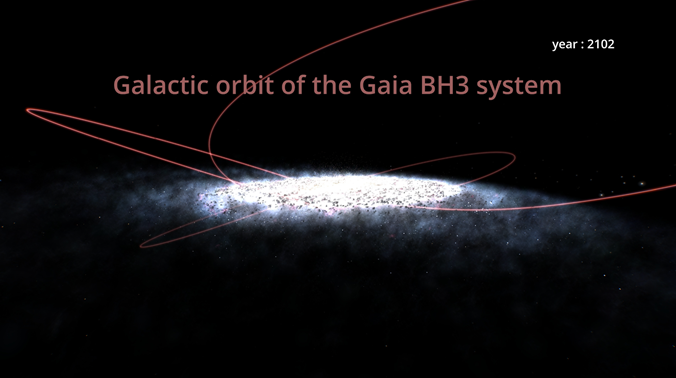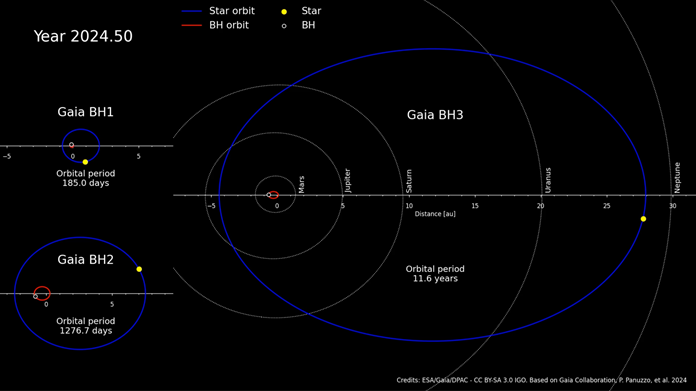While analysing a vast amount of data collected by the European Space Agency’s star surveyor Gaia, a research team including UW scientists has discovered a “sleeping” black hole. Its mass is estimated to be nearly thirty-three times the mass of the Sun, making it the greatest known example of this black hole in our galaxy. The discovery can influence the understanding of how massive stars evolve.
The majority of the few known black holes of stellar origin (resulting from the collapse of a massive star at the end of its life) have been identified in X-ray binaries. In these binaries, the X-ray emission is due to the matter lost by the star orbiting a black hole when it is sucked into the black hole. When the black hole does not have a companion close enough to steal matter from it, it does not emit any radiation, hence the extreme difficulty in detecting them.
On 16th April, the team of space mission Gaia announced in Astronomy & Astrophysics Letter the discovery of the third dormant black hole. This happened by accident when scientists were proving the data for the publication of the next Gaia catalogue. The team responsible for the discovery was the Black Hole Task Force. The lead author of the paper is Dr Pasquale Panuzzo from the Paris Observatory in France. The research team included also the scientists from the Astronomical Observatory, the University of Warsaw.
The team has examined an old star in the constellation Aquila, located at 1926 light years from the Earth. While analysing the star movement, the researchers discovered a surprising phenomenon. The star was orbiting with a dormant black hole, whose mass was around thirty three times greater than the Sun’s.

Galactic orbit of the Gaia BH3 system. Credits: ESA/Gaia/DPAC. License: CC BY-SA 3.0 IGO
The unexpectedly massive black hole was named Gaia BH3, because it was already the third dormant black hole discovered by the Gaia mission. Typical masses of black holes of stellar origin known in our galaxy are ten times greater than the mass of the Sun. The most massive example known to date is the black hole found in the X-ray binary system of the Cygnus constellation (Cyg X-1), whose mass is estimated to be around twenty times greater than the Sun’s.
Gaia BH3 is a real unicorn. This sort of discovery is made once in a lifetime. The existence of such massive stellar black holes has so far only been suggested by the detection of gravitational waves from systems in other galaxies,” Dr Panuzzo emphasised.
The quality of the data from the Gaia mission enabled the scientists to determine the mass of the black hole more precisely than ever before.

The picture presents Gaia’s black holes at their positions in the sky. These black holes are also the closest ones to Earth that we know of. The sky map in the background shows Gaia’s sky in colours and is not a picture. It is a visualisation where individual stars with their colours as observed by Gaia are plotted one by one. Credits: ESA/Gaia/DPAC. License: CC BY-SA 3.0 IGO
With a mass of thirty times greater than the Sun’s, we observe the results typical for black holes detected in distant galaxies via the experiments of gravitational waves. The surveys of the Gaia give us the first undoubtful prove for existing such heavy black holes,” said Prof. Łukasz Wyrzykowski from the UW’s Astronomical Observatory, a Gaia team member from 2008. The UW researcher belongs also to the Black Hole Task Force.
Intriguing companion
The star orbiting the Gaia BH3 is also unusual. It is a an old star in the Galactic stellar halo, which is orbiting in the opposite direction with respect to the stars of the Galactic disk. Its kinematic characteristics indicate that this star was part of a small galaxy that merged into the Milky Way over eight billion years ago.
Moreover, the accompanying star is also very poor in elements heavier than the lightest, hydrogen and helium, allowing the researchers to deduce that the progenitor of this high-mass black hole was a massive star, also very poor in heavy elements.
Surprisingly, the chemical composition of the companion is similar to that found in old, metal-deficient stars in the Galaxy,” explained Dr Milena Ratajczak from the UW’s Astronomical Observatory, a member of the Gaia consortium.
This observation confirms, for the first time, the hypothesis of certain models of stellar evolution which suggest that the high-mass black holes observed via gravitational waves were produced by the gravitational collapse of massive stars poor in heavy elements. These early stars could evolve differently than the large ones we are observing in our galaxy.

Comparison of the orbits of Gaia’s black holes (red orbit, black dot) and their companion stars (blue orbit, yellow dot). Credits: ESA/Gaia/DPAC. License: CC BY-SA 3.0 IGO
What next?
The question of how massive stars evolve and form black holes is still not fully resolved. However, the discovery of the Gaia BH3 system will undoubtedly be the subject of further research in this area. For now, it is only a preview of the full findings from Gaia, which are planned to be published in 2026.



